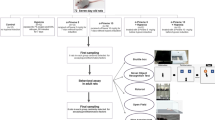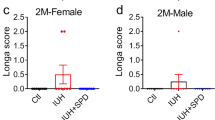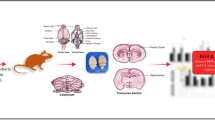Abstract
Maternal hypoxia due to a lack of blood flow and insufficient oxygen supply in the brain leads to behavioral disorders in adult offspring. Fish oil includes docosahexaenoic acid (DHA), a significant component of membrane phospholipids of nerve cells, which improved cognition, and memory. Trk family receptors are activated by hypoxic induction factor (HIF), and are involved in the neurotrophin’s protective effects at the cellular level. Here we studied the biochemical, and molecular mechanisms of the protective effect of fish oil during the chronic maternal hypoxia model on behavioral responses in male rat offspring. Pregnant female rats were randomly divided into 4 experimental groups: 1) ctr; Control rats were pregnant 2) Hyp; Pregnant female rats received hypoxia from 6 to 15th day of pregnancy, with 10% oxygen intensity, and 90% nitrogen; 3) FO; Pregnant female rats received fish oil (F8020 1 ml / day, for ten consecutive days Orally), and 4) FO / Hyp; Pregnant female rats received hypoxia plus fish oil in the same manner. Behavioral parameters were evaluated in 28-day-old male offspring. HIF-1α, TrkB, and P75 gene expression were measured in the offspring’s brain. Maternal hypoxia impaired memory performance, and locomotor activity in offspring. Besides, Trk family gene expression, and oxidative stress indicators showed a significant increase in the offspring’s brain exposed to maternal hypoxia compared to the control group. Overall, fish oil improved behavioral parameters by inhibiting oxidative stress, and the expression of Trk family receptors.





Similar content being viewed by others
Data availability
The data that support the findings of this study are available from the corresponding author upon reasonable request.
References
Albert BB et al (2017) Fish Oil Supplementation to Rats Fed High-Fat Diet during Pregnancy Prevents Development of Impaired Insulin Sensitivity in Male Adult Offspring. Sci Rep 7:1–11
Ali SS, Hardt JI, Dugan LL (2008) SOD activity of carboxyfullerenes predicts their neuroprotective efficacy: a structure-activity study. Nanomedicine: Nanotechnology. Biol Med 4:283–294
Bustin SA et al (2009) The MIQE Guidelines: M inimum I nformation for Publication of Q uantitative Real-Time PCR E xperiments. Oxford University Press
Correia C et al (2010) Increased BDNF levels and NTRK2 gene association suggest a disruption of BDNF/TrkB signaling in autism Genes. Brain Behav 9:841–848
Farombi EO (2000) Mechanisms for the hepatoprotective action of kolaviron: studies on hepatic enzymes, microsomal lipids and lipid peroxidation in carbontetrachloride-treated rats. Pharmacol Res 1:75–80
Getahun D et al (2013) In utero exposure to ischemic-hypoxic conditions and attention-deficit/hyperactivity disorder. Pediatrics 131:e53–e61
Ghotbeddin Z, Tabandeh MR, Borujeni MP, Truski FF, Tabrizian L (2018) Study the effect of crocin in three maternal hypoxia protocols with different oxygen intensities on motor activity and balance in rat offspring. Acta Neurol Belgica 1–7
Gould JF, Smithers LG, Makrides M (2013) The effect of maternal omega-3 (n-3) LCPUFA supplementation during pregnancy on early childhood cognitive and visual development: a systematic review and meta-analysis of randomized controlled trials. Am J Clin Nutr 97:531–544
Gupta VK, You Y, Gupta VB, Klistorner A, Graham SL (2013) TrkB receptor signalling: implications in neurodegenerative, psychiatric and proliferative disorders. Int J Mol Sci 14:10122–10142
Iraz M, Erdogan H, Ozyurt B, Ozugurlu F, Ozgocmen S, Fadillioglu E (2005) Omega-3 essential fatty acid supplementation and erythrocyte oxidant/antioxidant status in rats Annals of Clinical & Laboratory Science 35:169–173
Jang EA, Longo LD, Goyal R (2015) Antenatal Maternal Hypoxia: Criterion for Fetal Growth Restriction in Rodents. Front Physiol 6:176
Jiang Y, Wei N, Lu T, Zhu J, Xu G, Liu X (2011) Intranasal brain-derived neurotrophic factor protects brain from ischemic insult via modulating local inflammation in rats. Neuroscience 172:398–405
Jump DB (2004) Fatty Acid Regulation of Gene Transcription. Crit Rev Clin Lab Sci 41:41–78
Jung UJ, Torrejon C, Tighe AP, Deckelbaum RJ (2008) n− 3 Fatty acids and cardiovascular disease: mechanisms underlying beneficial effects. Am J Clin Nutr 87:2003S-2009S
Jusman SA, Halim A (2010) Oxidative stress in liver tissue of rat induced by chronic systemic hypoxia Makara. J Health Res 34–38
Lei X, Zhang W, Liu T, Xiao H, Liang W, Xia W, Zhang J (2013) Perinatal supplementation with omega-3 polyunsaturated fatty acids improves sevoflurane-induced neurodegeneration and memory impairment in neonatal rats. PLoS One 8
Levine TA, Grunau RE, McAuliffe FM, Pinnamaneni R, Foran A, Alderdice FA (2015) Early childhood neurodevelopment after intrauterine growth restriction: a systematic review. Pediatrics 135:126–141
Martens LK, Kirschner KM, Warnecke C, Scholz H (2007) Hypoxia-inducible factor-1 (HIF-1) is a transcriptional activator of the TrkB neurotrophin receptor gene. J Biol Chem 282:14379–14388
Minichiello L (2009) TrkB signalling pathways in LTP and learning. Nat Rev Neurosci 10:850–860
Miyata T, Takizawa S, Ypersele V, de Strihou C (2011) Hypoxia. 1. Intracellular Sensors for Oxygen and Oxidative Stress: Novel Therapeutic Targets. Am J Physiol-Cell Physiol 300:C226–C231
Moazedi A, Ghotbeddin Z, Parham G (2007) Comparison of the effects of dose-dependent zinc chloride on short-term and long-term memory in young male rats. Pak J Biol Sci 10:2704–2708
Panja D, Bramham CR (2014) BDNF mechanisms in late LTP formation: a synthesis and breakdown. Neuropharmacology 76:664–676
Ratnayake WN, Galli C (2009) Fat and fatty acid terminology, methods of analysis and fat digestion and metabolism: a background review paper. Ann Nutr Metab 55:8
Reichardt LF (2006) Neurotrophin-regulated signalling pathways. Philos Trans R Soc B 361:1545–1564
Sab I et al (2013) Prenatal hypoxia, habituation memory and oxidative stress. Pharmacol Biochem Behav 107:24–28
Vannucci SJ, Hagberg H (2004) Hypoxia–ischemia in the immature brain. J Exp Biol 207:3149–3154
Volpe JJ (2003) Cerebral white matter injury of the premature infant—more common than you think. Pediatrics 112:176–180
Wei B, Li L, He A, Zhang Y, Sun M, Xu Z (2016) Hippocampal NMDAR-Wnt-Catenin signaling disrupted with cognitive deficits in adolescent offspring exposed to prenatal hypoxia. Brain Res 1631:157–164
Weis SN et al (2012) Neonatal hypoxia–ischemia induces sex-related changes in rat brain mitochondria. Mitochondrion 12:271–279
Weiser MJ, Butt CM, Mohajeri MH (2016) Docosahexaenoic acid and cognition throughout the lifespan. Nutrients 8:99
Wu A, Ying Z, Gomez-Pinilla F (2004) Dietary omega-3 fatty acids normalize BDNF levels, reduce oxidative damage, and counteract learning disability after traumatic brain injury in rats. J Neurotrauma 21(10):1457–1467
Yang SG, Wang WY, Ling TJ, Feng Y, Du XT, Zhang X, Liu RT (2010) Alpha-tocopherol quinone inhibits beta-amyloid aggregation and cytotoxicity, disaggregates preformed fibrils and decreases the production of reactive oxygen species, NO and inflammatory cytokines. Neurochem Int 57:914–922
Zalkhani R, Moazedi A, Ghotbeddin Z, Pourmahdi Borujeni M (2019) The Effect of Sodium Valproate and Low Frequency Electrical Stimulation on Motor Activity During Rapid Kindling of Hippocampal CA1 Region in Adult Male Rat: An Experimental Study. J Rafsanjan Univ Med Sci 18:43–54
Zhu X, Gao Q, Tu Q, Zhong Y, Zhu D, Mao C, Xu Z (2016) Prenatal hypoxia enhanced angiotensin II-mediated vasoconstriction via increased oxidative signaling in fetal rats. Reprod Toxicol 60:21–28
Acknowledgements
This study was supported financially by Iran National Science Foundation, under project number 97014509. We are grateful to the Iran National Science Foundation and Research Council of the Shahid Chamran University of Ahvaz for financial support.
Funding
This work was supported by the Iran National Science Foundation, under project number 97014509. We are grateful to the Iran National Science Foundation and Research Council of the Shahid Chamran University of Ahvaz for financial support.
Author information
Authors and Affiliations
Contributions
Zohreh Ghotbeddin participated in study design, data collection, evaluation and, contributed to behavioral experiments and, was responsible for overall supervision. Kaveh Khazaeil and Mohammad Reza Tabandeh participated in study design, data collection, evaluation and contributed in other parts of the experiment. Maryam Aliheydari and Hooshyar Yaghoubi contributed to all experimental work and data statistical analysis. All the authors reviewed and approved the final manuscript.
Corresponding author
Ethics declarations
Conflict of interest
The authors declare that there is no conflict of interest.
Additional information
Publisher’s note
Springer Nature remains neutral with regard to jurisdictional claims in published maps and institutional affiliations.
Rights and permissions
About this article
Cite this article
Ghotbeddin, Z., Khazaeel, K., Tabandeh, MR. et al. Effects of omega-3 fatty acid supplementation during chronic maternal hypoxia on behavioral disorders in male rat offspring: the role of Trk family and oxidative stress. Metab Brain Dis 37, 1959–1967 (2022). https://doi.org/10.1007/s11011-022-01012-6
Received:
Accepted:
Published:
Issue Date:
DOI: https://doi.org/10.1007/s11011-022-01012-6




